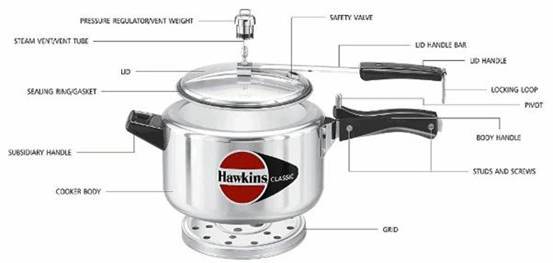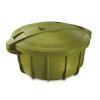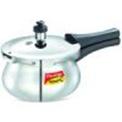Pressure cooking is a method of cooking that does not permit air or liquids to escape below a preset pressure in a sealed cooker.
The boiling point of water increases as the pressure in a cooker increases, so the steam that is formed builds up pressure inside the cooker which raises the boiling point of water and therefore the cooking temperature. Pressure is created at the beginning with boiling water, inside the closed pressure cooker and the trapped steam increases the internal pressure and temperature, which is maintained throughout cooking time. Normally open-pot cooking is done at the boiling point of water which produces steam at sea level at 100oC (212oF).
In a pressure cooker, the steam permeates through the food, tenderizing it, infusing it with flavour, and preserving nutrients, colour, texture and juices and the cooking process is faster. Most Indian pressure cookers cook food at 121oC (250oF) at a pressure of 15 lb per square inch (psi) which is equivalent to 1 kg per square cm.
An early pressure cooker, called a steam digester, was invented by Denis Papin, a French physicist, in 1679.

The picture shows two digesters;] both, however, on the same principle, and made of cast iron; No. 1 being of the smaller size, and No. 2 for any quantity from half a gallon upwards; the price being, according to the size, from 12 shillings to 30 shillings, and for the smaller sort half the former sum.
Murray's Modern Cookery Book, by a lady, c1851
Pressure cookers are used for different purposes. Some are used by laboratories and hospitals to sterilize materials and are known as an autoclave. Some are used in the food industry, especially as pressure canners, due to their capacity to hold jars used in canning.
Pressure cooking is often used to simulate the effects of long braising or simmering foods in shorter periods of time. Since pressure cooking depends on the production of steam, this process cannot be used easily for methods of cooking that produce little steam, such as roasting, pan frying or deep frying.


[Image source]
Stainless Steel
Stainless steel cookers allow hygienic cooking, as the metal surface is more resistant to pits and scratches than the softer aluminium. Also this material can handle acidic foods better. Since it’s harder than aluminium, the chances of accidental bursting from pressure build-up are reduced too. Stainless steel is easier to clean too.
Higher quality stainless steel pressure cookers are made with heavy copper-clad bottoms (this helps in heat spreading) for uniform heating, as stainless steel has lower thermal conductivity.
Stainless steel pressure cooker

[Image source]

[Image source]
Hard Anodised Aluminum:
This material is recommended by experts for making cookers. Hard anodised Aluminium is made when a layer of aluminium oxide is deposited over the aluminium sheet through electrolysis thus making it:
• It is five times harder than normal aluminium, thus reducing the risk of ruptures and
accidents while cooking.
• It is as good a heat conductor as aluminium.
• It is easier to clean the cookers made of this material than standard aluminium cookers.
Hard anodised aluminium pressure cooker
Parts of a Pressure Cooker [Image sources]
Aluminium Pressure Cooker

Hard Anodized Pressure Cooker

Using a Pressure Cooker
The cooker is taken out from the storage unit.
Two cups of water are poured into the cooker's body. 1 teaspoon (5 ml) lemon juice or vinegar (not for anodised cookers) is added to this water to prevent discolouring of the cooker. All the food that is required to be cooked is placed in the utensils with the right amount of water or liquids and placed inside the cooker.
The pressure regulator is removed from the steam vent. The steam vent is checked to ensure that it’s clear.
The sealing ring or gasket is seated properly. The cooker is closed with the lid and the cooker is placed on the stove (gas, electric, ceramic or halogen) on high heat.
When water boils, hot air and/or steam should be issued only from the steam vent. If steam comes out around the edge of the lid, centralization of the lid is checked thus: by unlatching and repositioning the lid by moving the lid slightly towards the spot where steam is escaping and re-latching.


[Image sources]
Once steam starts coming out of the steam vent steadily, the pressure regulator is placed on the steam vent and pressed down firmly. A click indicates that the pressure regulator is in position. In about 2 minutes, the cooker should come to full operating pressure.
After the pressure regulator is placed on the steam vent, after about two minutes, steam starts coming out of the pressure regulator slightly, with a very low hissing sound. Then steam emission increases to full force and the pressure regulator lifts with a whistling sound. The pressure inside the cooker at this time is usually about 15 pounds per square inch (1 kg per square cm).
The number of whistles that are let out depends on the duration of cooking desired, and also on the contents to be cooked.
Once the cooking process is complete the heat is turned off and the cooker is removed from the stove and placed aside, and allowed to cool for sometime before opening the lid.
During the process of cooking, the heat need not be kept higher than necessary to maintain the pressure inside. If the heat is too high, it costs more in terms of fuel consumed and the life of the gasket/sealing ring is reduced by this extra heat. If the heat is set too low e.g. minimum, food may be undercooked or pressure may be lost.
Most modern cookers are dishwasher safe, but in India cookers are washed by hand.
Design And Safety Features
Cooker body
Pressure cookers are generally made from aluminium or stainless steel. Aluminium may be stamped and buffed or anodized. Higher quality stainless steel pressure cookers are made with heavy copper-clad bottom (this helps in spreading of heat) for uniform heating, as stainless steel has lower thermal conductivity. Pressure cookers are usually heavy.
It helps in regulating pressure better, hence food cooks faster, thus saves fuel, and is also easier to insert and remove from the cooker lid.
Longer Lasting Sealing Ring/Gasket
The gasket is not exposed to food acids in the pressure cooker as it is seated in the rim of the lid, hence is long-lasting.
Rust Proof Components
The pressure cookers normally use special metal alloy handles, covered with heat withstanding plastic parts, and handle brackets to withstand rust.
The Role of Pressure
Water boils at 100°C under normal atmospheric conditions so water cannot get any hotter than that. However, if water is put under pressure by sealing the lid of the cooker so that no steam can escape into the air, the pressure on the water is increased and the water boils at a higher temperature.
Most pressure cookers have a working pressure setting of 15 psi over the existing atmospheric pressure. At this pressure boost, relative to sea-level atmospheric pressure, water boils at 122 °C (252 °F). Some pressure cookers have a lower maximum pressure than the industry standard 15 psi, or can be adjusted to different maximum pressures; cooking times will increase accordingly at lower pressures. This is often done by having different regulator weights or different pressure settings.
The higher temperature causes food to cook faster; pressure cooking can reduce normal cooking times by as much as half. Foods such as legumes (lentils, dried peas and beans) and tough cuts of meat can be cooked to perfection in a fraction of the normal time. For example, when pressure cooking at 15 psi, cooking times are typically as follows: Shredded cabbage is cooked in one minute, fresh green beans in three minutes, small to medium-sized potatoes cook in about six minutes, and a whole chicken takes only twenty minutes. Rice and daals can be cooked in ten minutes, instead of 45 minutes of simmering in ordinary utensils. Another advantage is that different items like daals, vegetables, rice etc can be cooked together at one time quickly and in a single cooker instead of using multiple utensils.
Because food cooks faster in a pressure cooker, fuel and therefore money is saved. Scientific research indicates that certain nutritive elements such as proteins and vitamins are better retained by pressure cooking. Also steaming is ideal for low-calorie, low-fat cooking. The higher temperatures that are maintained during pressure cooking produce more hygienic food.
Safety features
A gasket or sealing ring plays an important role in the cooker’s function. This forms a gas-tight seal that does not allow air or steam to escape between the pot and the lid; normally, the only way the steam can escape is through a regulator on the lid when the pressure has built up. In case the regulator is blocked, a safety valve is provided as a backup escape route for steam. The simplest safety valve is a loose-fitting rubber plug in the lid, held in place by steam pressure. If the pressure exceeds design limits, the plug pops out of its seat, thereby ensuring there are no explosions.
To seal the gasket, some pressure cookers have a lid lock with handles that works by placing the lid on the pot and twisting it about 30° to lock it in place.
Pressure cookers have a reputation as a dangerous method of cooking with the risk of explosion. Early pressure cookers were equipped with only a primary safety valve and were at a risk of explosion if poorly maintained like allowing food residues to block the release valve.
Modern pressure cookers typically have two or three independent safety valves, as well as some additional safety features, such as an interlock to prevent opening the lid while internal pressure exceeds atmospheric pressure. Another common safety feature is in the design of the gasket, which expands and releases excess pressure downward between the lid and the cooker body.
However, there is still a risk of explosion, especially if cookers are not thoroughly and regularly maintained in accordance with the manufacturer's instructions.
Design Variations in Cooker
With Indian kitchens gradually making a shift towards the open and smaller ones, the need for accessorizing the kitchen with great looking and compact products has become absolutely essential. Brands like Prestige and Hawkins are constantly innovating their products, to introduce cookers with new features to bring in new trends and also to appeal to the tastes of the consumers.
Apart from these two market leaders, Marlex, Nutan, Vinod, Butterfly, Pigeon, National etc are some of the other popular cooker brands that are available in the markets in the present day.
Presented below are some of the newer versions of cookers available in the markets.
Apple Cooker

This innovation in the pressure cooker segment is from the Prestige brand. With the introduction of pressure cookers in the shape of an apple, they have broken away from the normal mundane shapes.
Apple pressure cookers are attractive and a must have accessory for modern kitchens giving the kitchen a style statement is what the manufacturers feel. It is made of virgin aluminium and has sleek contours and top-of-the-line features meant for consumers having a taste for style. Apple Pressure cookers are available in four different variables; Green and Red Apple cookers, the hard anodized and polished aluminium cookers. Apart from the aesthetics, the pressure cooker is also designed and enhanced with unique features like a self-locating pivot for convenient closing, screw type body handle, stainless steel beam for easier handling, new design weight valve/ regulator etc.
Microchef

This cooker is from the Prestige brand. It combines microwave and pressure cooking thus being suitable for preparing local as well as international cuisines. The speedy cooking in microwave oven ensures saving time and energy. This innovative kitchen appliance not only maximises the use of microwave oven, but also preserves the nutrients that are otherwise lost while using an open vessel in the microwave oven. Healthy cooking is the unique selling proposition in this cooker.
Pressure Handi

The pressure handi is aesthetically designed taking inspiration from the traditional Indian handi to give the feel of traditional cooking in a modern kitchen appliance. It is made of polished Aluminium for a sleek look and durability. It can be easily opened and closed by ergonomically designed handles. It has a unique Pressure Indicator on the lid along with multiple safety features.
Inner Lid Cookers

These cookers are from the Prestige brand. They are available as cookers and handis too, which are unique in many ways. This range of pressure cookers are designed to withstand the rigour of Indian cooking for a long time, making them ideal for cooking and serving. The Nakshatra pressure cooker and handi come in vibrant finishes to compliment today's modern kitchens and offer the highest level of safety in inner lid pressure cookers.
[Image sources]








